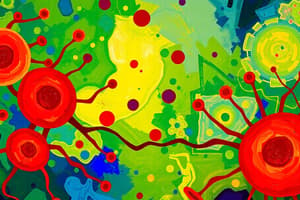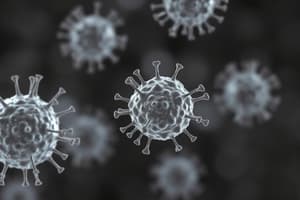Podcast
Questions and Answers
What factor is primarily responsible for exacerbating autoimmune diseases through T cell activation?
What factor is primarily responsible for exacerbating autoimmune diseases through T cell activation?
- Environmental toxins
- Adaptive immune response
- Commensal microbiota
- Inadequate self-tolerance (correct)
Which autoimmune disease is NOT mention as a result of single-gene mutations?
Which autoimmune disease is NOT mention as a result of single-gene mutations?
- Systemic lupus erythematosus (SLE)
- Antiphospholipid syndrome (APS)
- Autoimmune lymphoproliferative syndrome (ALPS)
- Rheumatoid arthritis (correct)
How might infections contribute to the development of autoimmunity?
How might infections contribute to the development of autoimmunity?
- By inducing apoptosis in self-reactive lymphocytes
- By promoting MHC mismatch
- By improving lymphocyte turnover
- By enhancing expression of costimulators (correct)
Which aspect is NOT a characteristic of the genetic basis of autoimmune diseases?
Which aspect is NOT a characteristic of the genetic basis of autoimmune diseases?
What is the primary role of helper T cells in the context of autoimmune diseases?
What is the primary role of helper T cells in the context of autoimmune diseases?
What is the primary outcome for immature T cells that recognize self antigens with high avidity during central tolerance?
What is the primary outcome for immature T cells that recognize self antigens with high avidity during central tolerance?
Which process is NOT a mechanism of peripheral T cell tolerance?
Which process is NOT a mechanism of peripheral T cell tolerance?
What role does the autoimmune regulator (AIRE) play in T cell tolerance?
What role does the autoimmune regulator (AIRE) play in T cell tolerance?
In central tolerance, what happens to B cells that encounter self antigens?
In central tolerance, what happens to B cells that encounter self antigens?
Which mechanism is primarily responsible for the functional unresponsiveness of self-reactive T cells?
Which mechanism is primarily responsible for the functional unresponsiveness of self-reactive T cells?
What is a key feature of central tolerance as it relates to T cells?
What is a key feature of central tolerance as it relates to T cells?
Which statement correctly describes peripheral tolerance?
Which statement correctly describes peripheral tolerance?
Which of the following is NOT a factor determining immunogenicity and tolerogenicity?
Which of the following is NOT a factor determining immunogenicity and tolerogenicity?
What is the role of TGF-β1 in T cell differentiation?
What is the role of TGF-β1 in T cell differentiation?
How does IL-10 influence macrophage activity?
How does IL-10 influence macrophage activity?
What is a key characteristic of tolerogenic antigens?
What is a key characteristic of tolerogenic antigens?
What occurs when immature B lymphocytes recognize self antigens in the bone marrow with high affinity?
What occurs when immature B lymphocytes recognize self antigens in the bone marrow with high affinity?
What describes central tolerance in lymphocytes?
What describes central tolerance in lymphocytes?
Which of the following statements about peripheral tolerance is true?
Which of the following statements about peripheral tolerance is true?
What is the consequence of the failure of self-tolerance in the immune system?
What is the consequence of the failure of self-tolerance in the immune system?
Which process does TGF-β promote following local immune reactions?
Which process does TGF-β promote following local immune reactions?
Which mechanism is primarily responsible for retaining the functionality of self-reactive T lymphocytes in peripheral tissues?
Which mechanism is primarily responsible for retaining the functionality of self-reactive T lymphocytes in peripheral tissues?
What condition occurs when B lymphocytes recognize self antigens without T cell assistance?
What condition occurs when B lymphocytes recognize self antigens without T cell assistance?
What is a common factor that increases the likelihood of developing autoimmunity?
What is a common factor that increases the likelihood of developing autoimmunity?
Which of the following describes the process by which immature B cells change their specificity in response to self-antigens?
Which of the following describes the process by which immature B cells change their specificity in response to self-antigens?
What is a primary consequence of defective self-tolerance in the immune system?
What is a primary consequence of defective self-tolerance in the immune system?
Which of the following describes an abnormal display of self antigens relevant to autoimmunity?
Which of the following describes an abnormal display of self antigens relevant to autoimmunity?
Which of the following best characterizes autoimmune diseases?
Which of the following best characterizes autoimmune diseases?
What critical role do regulatory T lymphocytes have in maintaining immune homeostasis?
What critical role do regulatory T lymphocytes have in maintaining immune homeostasis?
Which statement best describes the role of CTLA-4 in T cell regulation?
Which statement best describes the role of CTLA-4 in T cell regulation?
What is a consequence of TCR-induced signal transduction blockage in anergic T cells?
What is a consequence of TCR-induced signal transduction blockage in anergic T cells?
How do regulatory T cells (Tregs) primarily suppress immune responses?
How do regulatory T cells (Tregs) primarily suppress immune responses?
What role does interleukin-2 (IL-2) play in the function of regulatory T cells?
What role does interleukin-2 (IL-2) play in the function of regulatory T cells?
Which mechanism is directly involved in the degradation of TCR-associated proteins in anergic T cells?
Which mechanism is directly involved in the degradation of TCR-associated proteins in anergic T cells?
Which of the following accurately describes the engagement of inhibitory receptors in T cell tolerance?
Which of the following accurately describes the engagement of inhibitory receptors in T cell tolerance?
What is the primary function of TGF-β1 produced by regulatory T cells?
What is the primary function of TGF-β1 produced by regulatory T cells?
Which feature distinguishes CTLA-4 from CD28 in T cell regulation?
Which feature distinguishes CTLA-4 from CD28 in T cell regulation?
Study Notes
Central and Peripheral Tolerance
- Tolerance to self antigens is a fundamental property of the immune system
- Central tolerance occurs in the generative lymphoid organs (thymus and bone marrow) when immature lymphocytes encounter self antigens
- Peripheral tolerance occurs when mature lymphocytes recognize self antigens in peripheral tissues under particular conditions
- Immature lymphocytes specific for self antigens may encounter these antigens in the generative lymphoid organs (central organs) and are deleted, change their specificity (B cells only), or (CD4+ T cells) develop into regulatory lymphocytes (Tregs)
- Some self-reactive lymphocytes may mature and enter peripheral tissues and may be inactivated or deleted by an encounter with self antigens or are suppressed by Tregs
Central T Cell Tolerance
- Many immature T cells that recognize antigens with high avidity die (negative selection)
- Some surviving cells in the CD4+ lineage develop into Tregs
- The thymus expresses numerous protein antigens that are limited to certain peripheral tissues so that immature T cells specific for these antigens can be deleted
AIRE in T Cell Deletion
- The autoimmune regulator (AIRE) protein controls expression of peripheral tissue antigens in medullary thymic epithelial cells (MTECs)
Mechanisms of Peripheral T Cell Tolerance
- Peripheral tolerance mechanisms include anergy, suppression by Tregs, and deletion
- These mechanisms may be responsible for T cell tolerance to tissue-specific self antigens and foreign antigens presented under tolerogenic conditions
Mechanisms of T Cell Anergy
- TCR-induced signal transduction is blocked in anergic cells
- Self-antigen recognition without costimulation may activate ubiquitin ligases which target TCR-associated proteins for degradation
- When T cells recognize self antigens without innate immune responses they may engage inhibitory receptors of the CD28 family, which terminate T cell responses
Actions of CTLA-4
- CTLA-4 is expressed on Tregs and recently activated T cells
- CTLA-4 is a competitive inhibitor of CD28 and reduces the availability of B7 for CD28
- CTLA-4 prevents activation of responding T cells
- CTLA-4 on one T cell (a Treg) can inhibit responses of other T cells
- CTLA-4 and CD28 recognize the same ligands: B7-1 (CD80) and B7-2 (CD86)
Regulatory T Cells
- Tregs are a subset of CD4+ T cells that suppress immune responses
- Tregs express the transcription factor FoxP3
- Tregs play a crucial role in maintaining immune homeostasis and preventing autoimmunity
IL-2 in Maintaining Tregs
- Tregs consume IL-2, which is essential for their survival and function
- Tregs suppress immune responses by multiple mechanisms
Inhibitory Cytokines Produced by Tregs
- TGF-β1 produced by CD4+ Tregs inhibits T cell proliferation and function
- TGF-β1 stimulates production of IgA
- TGF-β1 promotes tissue repair
- IL-10 is an inhibitor of activated macrophages and dendritic cells
- IL-10 inhibits IL-12 production and co-stimulator expression
- IL-10 inhibits T cell activation and terminates cell-mediated immune reactions
Factors Determining Immunogenicity and Tolerogenicity of Protein Antigens
- Tolerogenic antigens are expressed in generative lymphoid organs
- The nature of the dendritic cell displaying antigens to T lymphocytes is an important determinant of the subsequent response
Central Tolerance in B Cells
- Immature B cells that recognize self antigens in the bone marrow change their specificity or are deleted
- Mature B cells that recognize self antigens in peripheral tissues without helper T cells may become unresponsive or die by apoptosis
Summary of Tolerance Mechanisms
- Immunologic tolerance is unresponsiveness to an antigen
- Central tolerance is induced in the generative lymphoid organs when immature lymphocytes encounter self antigens
- Peripheral tolerance occurs when mature lymphocytes recognize self antigens in peripheral tissues
- Some immature T cells that encounter self antigens in the thymus die by negative selection
- Anergy is induced by antigen recognition without adequate costimulation
- Central tolerance in B cells is induced when immature B cells recognize self antigens in the bone marrow resulting in receptor editing or apoptotic death
- Mature B cells that recognize self antigens in the periphery without T cell help may be rendered anergic or become functionally unresponsive
Postulated Mechanisms of Autoimmunity
- Factors that contribute to autoimmunity include genetic susceptibility and environmental triggers
- Autoimmune diseases may be systemic or organ specific
Effector Mechanisms of Autoimmunity
- Effector mechanisms of autoimmunity include immune complexes, circulating autoantibodies, and autoreactive T lymphocytes
Immunologic Abnormalities Leading to Autoimmunity
- Autoimmune diseases result from inadequate self-tolerance or regulation of lymphocytes
- Defects in deletion of T or B cells
- Defective numbers or functions of regulatory T lymphocytes
- Defective apoptosis of mature lymphocytes
- Inadequate function of inhibitory receptors
- Abnormal display of self antigens
- Inflammation or an initial innate immune response may contribute to autoimmunity
Genetic Basis of Autoimmunity
- Most autoimmune diseases are polygenic
- The greatest genetic contribution is from MHC genes
Examples of Single-Gene Mutations That Cause Autoimmunity
- Antiphospholipid syndrome (APS)
- Systemic lupus erythematosus (SLE)
- Autoimmune lymphoproliferative syndrome (ALPS)
- Immune dysregulation, polyendocrinopathy, enteropathy, X-linked (IPEX) syndrome
Role of Infections in Autoimmunity
- Infections may enhance expression of costimulators in tissues
- Infections may trigger cross reactions between microbial antigens and self antigens
Summary of Autoimmunity
- Autoimmunity results from inadequate self-tolerance or regulation of lymphocytes
- Autoimmune reactions may be triggered by environmental stimuli in genetically susceptible individuals
- Most autoimmune diseases are polygenic
- Additional genes are believed to influence the selection or regulation of self-reactive lymphocytes
- Infections may predispose to autoimmunity
- Some infections may protect individuals from autoimmunity
Studying That Suits You
Use AI to generate personalized quizzes and flashcards to suit your learning preferences.
Related Documents
Description
Explore the concepts of central and peripheral tolerance within the immune system. This quiz covers how immature and mature lymphocytes interact with self antigens and the implications of these processes for immune regulation. Learn about the mechanisms that prevent autoimmunity through central and peripheral tolerance.




